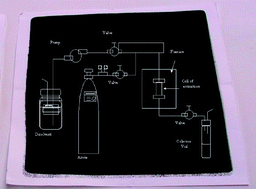The feasibility of pressurized chelating solvents [ethylenediaminotetracetic acid (EDTA) dipotassium salt, 1,10-ortho-phenanthroline (PHEN), 8-hydroxyquinoline (8HQ), chloramine-T (CT), 1,1,1-trifluoro-2,4-pentanedione (H(fta)), 2,2′-azobis-(2-methylpropionamidine) dihydrochloride (AMPAHC) and 1,5-diphenylcarbazone (DFC)] has been investigated from a novel aspect to speed up metals leaching from atmospheric particulate matter (PM10). The target elements (Ca, Cd, Co, Cr, Cu, Fe, Mg, Mn, Na, Ni, Pb, Sr, V and Zn) have been evaluated by inductively coupled plasma-optical emission spectrometry (ICP-OES). The highest metal recoveries (within the 85–100% range) were found when using EDTA. Variables inherent to pressurized liquid extraction (temperature, chelating solvent concentration, static time, pressure, number of cycles, dispersing agent mass, flush volume and purge time) were simultaneously studied by applying a Plackett–Burman design (PBD) as the screening method. Results showed statistical significance for some factors such as extraction temperature and EDTA concentration. The static time and the number of cycles were statistically non-significant for most of the elements, meaning that the pressurized leaching procedure can be finished after 12 min (5 min for pre-heating the extraction cell at 100 °C plus 5 min of static time plus 1 min of purge time plus 1 min of end relief time). In addition, the presence of dispersing agent was not necessary, which reduces the time for filling of the cells. Quantitative recoveries for all metals were reached under the following extraction conditions: 40 mM EDTA, extraction temperature of 100 °C, pressure of 1000 psi, static time of 5 min and one extraction cycle. Analytical performances, such as limits of detection and quantification and repeatability of the over-all procedure, have been established. Finally, results obtained by EDTA-based pressurized liquid extraction have been found to be statistically comparable with those obtained after conventional acid digestion with nitric, hydrofluoric and perchloric acids.


 Please wait while we load your content...
Please wait while we load your content...